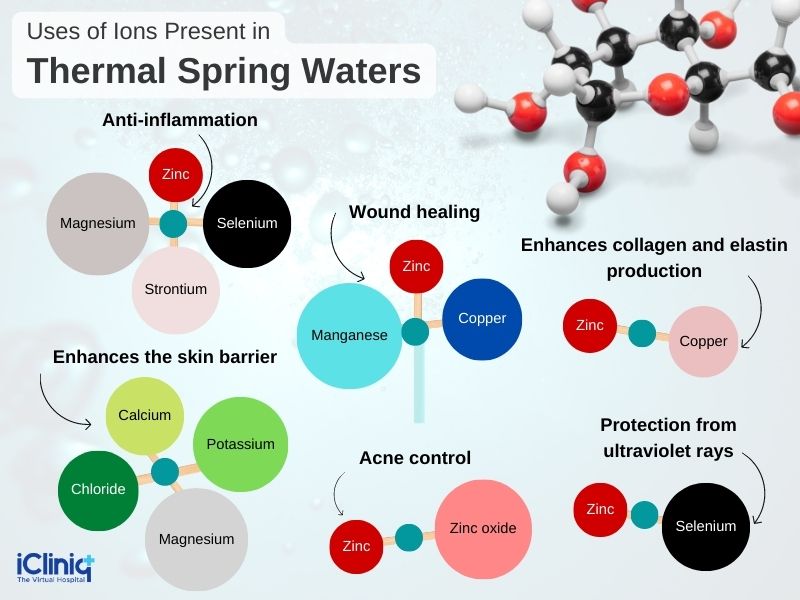Introduction:
Metal ion complexes are anionic, cationic, or neutral species coordinated by ligands. Researchers have used these metal ion complexes to design drugs and cosmetics. They exhibit different oxidation states and therefore demonstrate unique applications. The recent advances in inorganic chemistry have led to the development of metal ion complexes in the field of cosmetology. Besides its side effects, it stands for its unique properties.
What Are the Ions Present in Thermal Spring Waters, and What Are Their Uses?
Thermal spring water is naturally mineralized water that has spring origin, bacteriological purity, and therapeutic properties. They have abundant calcium, magnesium, chlorides, sulfates, and bicarbonate ions and trace amounts of zinc, copper, fluoride, and manganese.

What Are the Various Metal Ion Complexes and Their Role in Skin?
-
Aluminum: Aluminum salts are commonly used in antiperspirant products as they obstruct hair follicles and sweat ducts, and sebaceous glands. Aluminum hydroxide and aluminum phosphate can treat hyperhidrosis (excessive sweating).
-
Silver: Aqueous solution of silver nitrate is used to treat wounds. Sulfadiazine was added to silver ions to stabilize the silver so as not to get reduced to silver oxide and used for wound care. A cream containing silver sulfadiazine is used to treat burns. The combination of silver and sulfadiazine is also used in bandages and traumatic injuries. Silver salts and colloidal silver are added as preservatives in skin care products such as cleansers, antiperspirants, and exfoliating products.
-
Potassium: It regulates the skin's barrier function and maintains homeostasis.
-
Calcium: The topical application of potassium compounds improves the skin barrier by promoting keratinocyte differentiation.
-
Magnesium: It has properties similar to calcium and is used to improve the skin barrier. In addition, they have anti-inflammatory properties.
-
Selenium: Even at low concentrations, selenium can protect the skin from ultraviolet radiation. They were able to protect against UV-A but not UV-B rays. They also exhibit anti-inflammatory properties in combination with strontium.
-
Zinc and Copper: They are trace elements, yet they exhibit soothing properties on the skin. Copper is good at wound healing and promotes collagen and elastin production. Zinc compounds are used in cosmetics and medicine. Zinc pyrithione is active against seborrheic dermatitis, scalp itch, and dandruff. Zinc sulfate and zinc gluconate have antimicrobial properties and can regulate sebum production in the skin. The zinc oxide nanoparticles can protect against UV-A (ultraviolet A) and UV-B rays. Zinc oxide, at a pH (potential of hydrogen) lower than 6, can exhibit soothing effects on the skin.
-
Nickel: It acts as a skin sensitizer and can penetrate the stratum corneum, partition the epidermis, and reacts with endogenous proteins.
What Are Allantoin Metal Complexes?
-
Allantoin is a metabolic product of uric acid added to skin and hair care products. It is well tolerated by skin and hair due to its soothing properties.
-
They improve skin elasticity by promoting collagen and elastin production.
-
They are used to treat skin sores and bed sores.
-
The combination of allantoin, heparin, and dexpanthenol was found to regress erythematous skin lesions caused by ultraviolet radiation.
-
Allantoin is usually complex with ionic metals such as copper, tin, and zinc and salts such as chloride, phosphate, acetate, and maleate.
-
Allantoin-ion complexes aid in wound healing.
-
Allantoin is hydrolyzed to adjust the pH of the skin care product, and allantoin-ion complexes are used to treat burns, inflammation, and minor irritations caused due to oxidative stress.
-
Allantoin-ion complexes increase hair follicles' size and boost the growth rate. Significant changes are noted by using the allantoin-copper complex.
What Are the Metal Contents in a Human Hair Fiber?
-
Human hair fiber contains alkali, alkaline earth, and transition metal ions. Iron, copper, calcium, magnesium, zinc, and lead are the most common metals in human hair. In addition, hair is rich in sulfur, and it is believed that metals combine with these metals to bond. It is observed that hair absorbs more alkali earth metals.
-
The uptake of metal ions in the hair also depends on the age and gender of the individual.
-
Melanin pigment in hair binds to calcium, magnesium, iron, and copper.
-
There is metal uptake in the hair during the cleansing and styling of hair. Calcium soap deposits on the surface of hair can result in stiffness and dryness of the hair. This alters hair response to treatments like straightening, bleaching, and dyeing.
What Is the Role of Metal Ions in Bleaching?
-
Bleaching the hair leads to oxidation of the protein contents in the hair. This would create anionic sites on the hair, allowing more metal to be attracted toward the hair.
-
The more the metal uptake, the more damage to the hair. This is the reason for the low strength of the hair and makes it difficult to maintain and style hair.
-
Hair consists of iron and copper metal ions. They can decompose hydrogen peroxide during hair coloring, thus causing the oxidation of free radicals and significantly damaging the hair.
What Are the Toxic Effects of Metal Ions?
-
Nickel, chromium, and cobalt, due to their high density, high melting point, and stabilization, are used in manufacturing cosmetic dyes and other products. These metals easily penetrate the skin and can cause allergic contact dermatitis and allergic contact urticaria.
-
Methyl mercury used in cosmetics for its antiseptic properties is commonly used for skin lightening in dark-skinned people, but unfortunately, they turn the skin darker on continuous use.
-
Chronic exposure to mercury in the products can lead to contact dermatitis, burning of the face, purpura, erythroderma, and flushing.
Conclusion:
The field of chemistry influenced the development of metal-based cosmetics, which led to the development of products with less toxic effects and more benefits. However, metal ions are not found to be very much beneficial to hair. But, further studies of the mechanism of action of each component have led to the development of this design of effective cosmetics.













